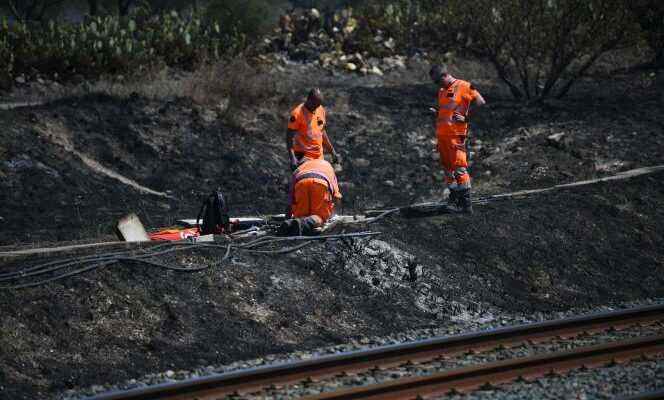Extreme heat and the rail network do not mix well. In Brittany, catenary problems and fires along the tracks cut off train traffic between Rennes and Brest on Monday July 18. Another fire further disrupted traffic on Wednesday between Rennes and Lamballe. Tuesday evening, a Thalys Paris-Amsterdam which had just left (late) remained immobilized for four hours very close to Paris. Finally, traffic was suspended for more than two hours on Wednesday morning in Hauts-de-France due to a power cut linked to the heat wave.
“Several incidents took place this week in a period of many trips, due to technical problems and high temperatures”soberly commented on Twitter the new delegate minister in charge of transport, Clément Beaune, during a quick visit to the SNCF crisis unit, Wednesday July 20. “Since the middle of last week, we have been managing both an episode of very heavy traffic and an episode of high heat which peaked on Monday and Tuesday. It must be recognized that this had a number of consequences for our customers”reports for its part the direction of the SNCF.
What are the repercussions of the heat wave on the rail infrastructure? What are the SNCF and the RATP doing to prevent and limit incidents in the event of high heat? How do the two public companies anticipate the effects of global warming on its equipment? The world make the point.
What are the consequences of high temperatures on railway infrastructure?
“Our rail network was not designed with the prospect of such temperatures in mind”, had declared on Public Senate, June 28, 2019, Elisabeth Borne, then Minister of Transport. France was already facing a heat wave with maximum temperatures between 35 degrees (°C) and 40°C. Mme Borne had recommended to those who could to postpone their trips.
Monday, July 18 was the hottest day recorded in France since August 5, 2003 (the national thermal indicator for maximum temperatures reached 37.6°C, compared to 37.7°C in 2003). Fires at the edge of the tracks, deformation of the tracks, tearing of the catenary, breakdown of air conditioning… intense heat can seriously harm the rail system:
- Summer heat and drought are likely to cause fires near tracks. These “slope fires”, as they are called, are sometimes caused by “the sparks created by the friction of the wheels of the trains on the rails during braking”specifies the SNCF, which adds that other reasons can be at the origin of these fires: “burning (clearing by fire carried out by farmers and breeders), a badly extinguished cigarette, not to mention acts of recklessness or malevolence”.
- “If the outside temperature is 37°C, that of the rail can exceed 55°C”notes the SNCF on his site. However, a rail is made up of 95% steel, a material sensitive to temperature variations: when it heats up, it expands and lengthens. This expansion of the steel is contained, to a certain extent, by a frame. But above 45°C there is a risk of deformation of the track, which can lead to derailment of the train.
- The catenary, it is the set of cables allowing the electrical supply of the trains. And the pantograph is the articulated arm located above the train that is used to capture the current and transmit it. To operate correctly, the power supply cables must be straight. But, when it is very hot, the catenary, which is made of copper, relaxes, explains the SNCF. The pantograph then risks damaging or even tearing the catenary, and the train can no longer roll. Thanks to the batteries on board, the air conditioning can be maintained for thirty minutes.
You have 60.28% of this article left to read. The following is for subscribers only.
